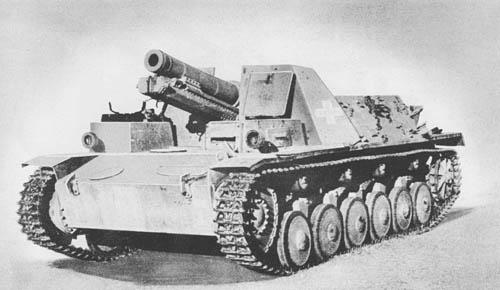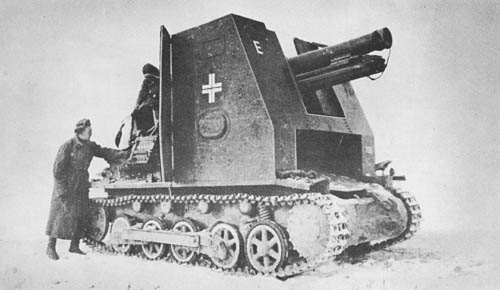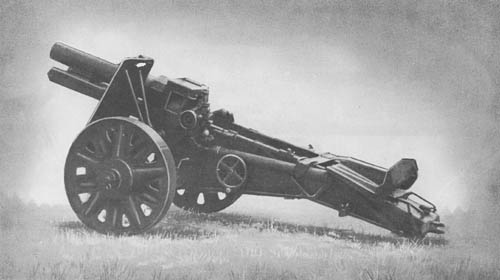
This vehicle consists of the 15 cm. heavy infantry howitzer mounted in the hull of a modified, turretless Pz. Kpfw. II chassis. The chassis is approximately three feet longer than that of the standard Pz Kw II tank and has six bogie wheels instead of the usual five. The sprockets, rear idlers, bogie wheels, return rollers, steering assembly, gear box and hull nose are those of the Pz. Kpfw. II; the instrument panel is that of a Pz. Kpfw. III. The front shield is in one piece extending straight across the full width of the superstructure. The driver’s visor is of the double shutter type. The road performance of this equipment approximates that of the Pz. Kpfw. II tank.
The gun, a standard infantry support weapon, is mounted low in the hull, projecting through a vertical slot in the shield. The gun shield is 15 mm thick and is of shallow construction. It extends about a third of the distance of the superstructure to the rear. Unlike the “Wasp” there are no protecting side plates along the entire length of the superstructure.
The gun is 64.57 inches in length, has a muzzle velocity of 790 f.s. and a maximum effective range of 5140 yards. The casting containing the recuperator and buffer, housed underneath the barrel, extends almost to the end of the barrel. The breech mechanism is similar to the 10.5 cm. I.F.H. 18. The elevating qear is operated from the right and the traversing gear from the left. In field mounting its traverse is 11°, its elevation 0° to +73°.
Two types of ammunition are fired, the 15 cm. I. Gr. 33 and the 15 cm. I. Gr. 38. The H.E. capacity is high, 21.8%. The only other shell that the weapon is known to fire is a smoke shell, the 15 cm. I. Gr. 38 Nb. The same percussion fuze, s. I. Gr. Z. 23, which weighs 75 lbs., is used in each case.
SPECIFICATIONS
| Weight | (approx.) 12 tons | |
| Length | (approx.) 18 ft. | |
| Width | 7 ft., 4 ins. | |
| Height (approx.) | 5 ft., 6 ins. | |
| Ground clearance | 13 ins. | |
| Tread centers | 6 ft., 2 ins. | |
| Ground contact | ||
| Width of track | 11 1/8 ins. | |
| Pitch of track | 3 5/8 ins. | |
| Track links | ||
| Fording depth | 3 ft. | |
| Theoretical radius of action | ||
| Roads | 118 miles | |
| Cross-country | 78 miles | |
| Speed | ||
| Roads | 25 m.p.h. | |
| Cross-country | 15 m.p.h. | |
| Armor | ||
| Front plate | 15 + 20 mm | |
| Sides | 15 mm | |
| Gun shield | 15 mm | |
| Armament | 15 cm. s.I.G. 33 | |
| Ammunition (rds.) | ||
| Engine | 140 B.H.P. Maybach, HL 62 TRM | |
| Transmission | 6 forward speeds, 1 reverse | |
| Steering | Epicyclic clutch brake | |
| Crew | Probably 4 |
German: p. 13

